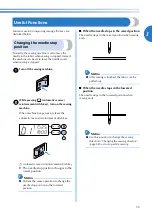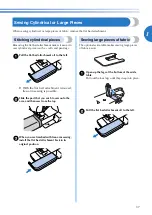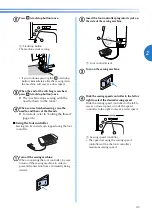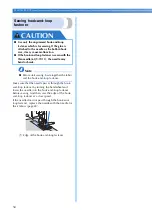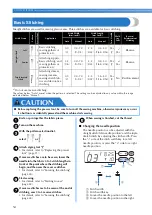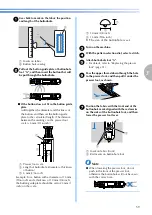
49
2
■
If thick seams are being sewn and the fabric
does not feed at the beginning of stitching
The fabric may not feed when thick seams are
being sewn and the presser foot is not level, as
shown below. In this case, use the presser foot
locking pin (black button on the left side of zigzag
foot “J”) so that the presser foot remains level
while sewing, allowing the fabric to be fed
smoothly.
a
Sewing direction
b
Misalignment
a
Raise the presser foot lever.
b
Align the beginning of stitching, and then
position the fabric.
c
While holding zigzag foot “J” level, hold the
presser foot locking pin (black button on the
left side) pressed in, and lower the presser
foot lever.
a
Presser foot holding pin (black button)
d
Release the presser foot locking pin (black
button).
X
The presser foot remains level, allowing
the fabric to be fed.
• After the seam is sewn, the presser foot will
return to its normal operation.
Sewing thin fabrics
When sewing thin fabrics, the stitching may become
misaligned or the fabric may not feed correctly.
If this occurs, place thin paper or stabilizer material
under the fabric and sew it together with the fabric.
When you have finished sewing, tear off any excess
paper.
a
Stabilizer material or paper
Sewing stretch fabrics
First, baste the pieces of fabric together, and then
sew without stretching the fabric.
In addition, a better result can be achieved by using
thread for knits or a stretch stitch.
a
Basting
b
a
a
CAUTION
●
The thickness of fabric differs depending on the
fabric type. If the fabric is forcefully pushed,
the needle may break or bend.
a
a
Summary of Contents for 885-V15
Page 2: ......
Page 112: ...English 885 V15 Printed in China XF6232 001 ...

